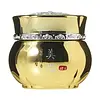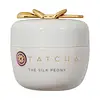What's inside
What's inside
 Key Ingredients
Key Ingredients

 Benefits
Benefits

 Concerns
Concerns

 Ingredients Side-by-side
Ingredients Side-by-side

Panax Ginseng Root Water
MaskingPanax Ginseng Root Extract
EmollientGlycerin
HumectantButylene Glycol
HumectantAlcohol
AntimicrobialCetearyl Alcohol
EmollientCetyl Ethylhexanoate
EmollientWater
Skin ConditioningVelvet Extract
HumectantButylene Glycol Dicaprylate/Dicaprate
EmollientHydrogenated Polydecene
EmollientPropanediol
SolventButyrospermum Parkii Butter
Skin ConditioningGanoderma Lucidum Extract
Skin ProtectingStearic Acid
CleansingPalmitic Acid
EmollientCetearyl Olivate
Behenyl Alcohol
EmollientHydrogenated Vegetable Oil
EmollientMacadamia Ternifolia Seed Oil
EmollientGlyceryl Stearate
EmollientDipentaerythrityl Hexahydroxystearate/Hexastearate/Hexarosinate
Skin ConditioningPanthenol
Skin ConditioningPhellinus Baumii Mycelium/Panax Ginseng Root Ferment Extract Filtrate
Skin ConditioningSorbitan Olivate
EmulsifyingCI 77480
Cosmetic ColorantPanax Ginseng Cell Culture Extract
Skin ConditioningZingiber Officinale Root Extract
MaskingPoria Cocos Extract
Skin ConditioningGlycyrrhiza Glabra Root Extract
BleachingTriticum Vulgare Flour Extract
Skin ConditioningSesamum Indicum Seed Oil
EmollientHoney Extract
HumectantCoptis Japonica Root Extract
Skin ConditioningSh-Octapeptide-4
AntioxidantHydrolyzed Hyaluronic Acid
HumectantTheobroma Cacao Extract
Skin ConditioningGlycyrrhiza Uralensis Extract
EmollientDextrin
AbsorbentCitric Acid
BufferingDimethicone
EmollientGlyceryl Acrylate/Acrylic Acid Copolymer
HumectantBeeswax
Emulsion StabilisingPolyacrylate-13
Tocopheryl Acetate
AntioxidantPolyisobutene
Arginine
MaskingPolysorbate 20
EmulsifyingSorbitan Isostearate
EmulsifyingMica
Cosmetic ColorantCI 77891
Cosmetic ColorantCI 77489
Cosmetic ColorantAdenosine
Skin ConditioningDisodium EDTA
Phenoxyethanol
PreservativeChlorphenesin
AntimicrobialCaprylyl Glycol
EmollientEthylhexylglycerin
Skin ConditioningParfum
MaskingPanax Ginseng Root Water, Panax Ginseng Root Extract, Glycerin, Butylene Glycol, Alcohol, Cetearyl Alcohol, Cetyl Ethylhexanoate, Water, Velvet Extract, Butylene Glycol Dicaprylate/Dicaprate, Hydrogenated Polydecene, Propanediol, Butyrospermum Parkii Butter, Ganoderma Lucidum Extract, Stearic Acid, Palmitic Acid, Cetearyl Olivate, Behenyl Alcohol, Hydrogenated Vegetable Oil, Macadamia Ternifolia Seed Oil, Glyceryl Stearate, Dipentaerythrityl Hexahydroxystearate/Hexastearate/Hexarosinate, Panthenol, Phellinus Baumii Mycelium/Panax Ginseng Root Ferment Extract Filtrate, Sorbitan Olivate, CI 77480, Panax Ginseng Cell Culture Extract, Zingiber Officinale Root Extract, Poria Cocos Extract, Glycyrrhiza Glabra Root Extract, Triticum Vulgare Flour Extract, Sesamum Indicum Seed Oil, Honey Extract, Coptis Japonica Root Extract, Sh-Octapeptide-4, Hydrolyzed Hyaluronic Acid, Theobroma Cacao Extract, Glycyrrhiza Uralensis Extract, Dextrin, Citric Acid, Dimethicone, Glyceryl Acrylate/Acrylic Acid Copolymer, Beeswax, Polyacrylate-13, Tocopheryl Acetate, Polyisobutene, Arginine, Polysorbate 20, Sorbitan Isostearate, Mica, CI 77891, CI 77489, Adenosine, Disodium EDTA, Phenoxyethanol, Chlorphenesin, Caprylyl Glycol, Ethylhexylglycerin, Parfum
Saccharomyces/Rice Ferment Filtrate
Skin ConditioningWater
Skin ConditioningGlycerin
HumectantPropanediol
SolventSqualane
EmollientDimethicone
EmollientBehenyl Alcohol
EmollientMyristyl Myristate
EmollientGlyceryl Stearate Se
EmulsifyingCera Alba
EmollientWhey Protein
Skin ConditioningInositol
HumectantSilica
AbrasiveCaprylic/Capric/Myristic/Stearic Triglyceride
EmollientCamellia Sinensis Leaf Extract
AntimicrobialCladosiphon Okamuranus Extract
Skin ConditioningPaeonia Albiflora Flower Extract
TonicHydrolyzed Silk
HumectantSericin
Skin ConditioningGeranium Robertianum Extract
AstringentChondrus Crispus Extract
Skin ConditioningYeast Ferment Extract
Skin ConditioningSargassum Vulgare Extract
Skin ConditioningSodium Hyaluronate
HumectantIsostearic Acid
CleansingSodium Stearoyl Glutamate
CleansingSodium Polyacrylate Starch
AbsorbentStearyl Alcohol
EmollientSorbitan Isostearate
EmulsifyingPolysorbate 60
EmulsifyingTocopheryl Acetate
AntioxidantTocopherol
AntioxidantHydroxyethyl Acrylate/Sodium Acryloyldimethyl Taurate Copolymer
Emulsion StabilisingSodium Benzoate
MaskingGluconolactone
Skin ConditioningButylene Glycol
HumectantEthylhexylglycerin
Skin ConditioningParfum
MaskingPhenoxyethanol
PreservativeCitral
PerfumingLimonene
PerfumingLinalool
PerfumingMica
Cosmetic ColorantTin Oxide
AbrasiveCI 77891
Cosmetic ColorantSaccharomyces/Rice Ferment Filtrate, Water, Glycerin, Propanediol, Squalane, Dimethicone, Behenyl Alcohol, Myristyl Myristate, Glyceryl Stearate Se, Cera Alba, Whey Protein, Inositol, Silica, Caprylic/Capric/Myristic/Stearic Triglyceride, Camellia Sinensis Leaf Extract, Cladosiphon Okamuranus Extract, Paeonia Albiflora Flower Extract, Hydrolyzed Silk, Sericin, Geranium Robertianum Extract, Chondrus Crispus Extract, Yeast Ferment Extract, Sargassum Vulgare Extract, Sodium Hyaluronate, Isostearic Acid, Sodium Stearoyl Glutamate, Sodium Polyacrylate Starch, Stearyl Alcohol, Sorbitan Isostearate, Polysorbate 60, Tocopheryl Acetate, Tocopherol, Hydroxyethyl Acrylate/Sodium Acryloyldimethyl Taurate Copolymer, Sodium Benzoate, Gluconolactone, Butylene Glycol, Ethylhexylglycerin, Parfum, Phenoxyethanol, Citral, Limonene, Linalool, Mica, Tin Oxide, CI 77891
 Reviews
Reviews

Ingredients Explained
These ingredients are found in both products.
Ingredients higher up in an ingredient list are typically present in a larger amount.
Behenyl Alcohol is a type of fatty alcohol (these are different from the drying, solvent alcohols).
Fatty Alcohols have hydrating properties and are most often used as an emollient or to thicken a product. They are usually derived from natural fats and oils; behenyl alcohol is derived from the fats of vegetable oils.
Emollients help keep your skin soft and hydrated by creating a film that traps moisture in.
In 2000, Behenyl Alcohol was approved by the US as medicine to reduce the duration of cold sores.
Learn more about Behenyl AlcoholButylene Glycol (or BG) is used within cosmetic products for a few different reasons:
Overall, Butylene Glycol is a safe and well-rounded ingredient that works well with other ingredients.
Though this ingredient works well with most skin types, some people with sensitive skin may experience a reaction such as allergic rashes, closed comedones, or itchiness.
Learn more about Butylene GlycolCi 77891 is a white pigment from Titanium dioxide. It is naturally found in minerals such as rutile and ilmenite.
It's main function is to add a white color to cosmetics. It can also be mixed with other colors to create different shades.
Ci 77891 is commonly found in sunscreens due to its ability to block UV rays.
Learn more about CI 77891Dimethicone is a type of synthetic silicone created from natural materials such as quartz.
What it does:
Dimethicone comes in different viscosities:
Depending on the viscosity, dimethicone has different properties.
Ingredients lists don't always show which type is used, so we recommend reaching out to the brand if you have questions about the viscosity.
This ingredient is unlikely to cause irritation because it does not get absorbed into skin. However, people with silicone allergies should be careful about using this ingredient.
Note: Dimethicone may contribute to pilling. This is because it is not oil or water soluble, so pilling may occur when layered with products. When mixed with heavy oils in a formula, the outcome is also quite greasy.
Learn more about DimethiconeEthylhexylglycerin (we can't pronounce this either) is commonly used as a preservative and skin softener. It is derived from glyceryl.
You might see Ethylhexylglycerin often paired with other preservatives such as phenoxyethanol. Ethylhexylglycerin has been found to increase the effectiveness of these other preservatives.
Glycerin is already naturally found in your skin. It helps moisturize and protect your skin.
A study from 2016 found glycerin to be more effective as a humectant than AHAs and hyaluronic acid.
As a humectant, it helps the skin stay hydrated by pulling moisture to your skin. The low molecular weight of glycerin allows it to pull moisture into the deeper layers of your skin.
Hydrated skin improves your skin barrier; Your skin barrier helps protect against irritants and bacteria.
Glycerin has also been found to have antimicrobial and antiviral properties. Due to these properties, glycerin is often used in wound and burn treatments.
In cosmetics, glycerin is usually derived from plants such as soybean or palm. However, it can also be sourced from animals, such as tallow or animal fat.
This ingredient is organic, colorless, odorless, and non-toxic.
Glycerin is the name for this ingredient in American English. British English uses Glycerol/Glycerine.
Learn more about GlycerinMica is a naturally occurring mineral used to add shimmer and color in cosmetics. It can also help improve the texture of a product or give it an opaque, white/silver color.
Serecite is the name for very fine but ragged grains of mica.
This ingredient is often coated with metal oxides like titanium dioxide. Trace amounts of heavy metals may be found in mica, but these metals are not harmful in our personal products.
Mica has been used since prehistoric times throughout the world. Ancient Egyptian, Indian, Greek, Roman, Aztec, and Chinese civilizations have used mica.
Learn more about MicaParfum is a catch-all term for an ingredient or more that is used to give a scent to products.
Also called "fragrance", this ingredient can be a blend of hundreds of chemicals or plant oils. This means every product with "fragrance" or "parfum" in the ingredients list is a different mixture.
For instance, Habanolide is a proprietary trade name for a specific aroma chemical. When used as a fragrance ingredient in cosmetics, most aroma chemicals fall under the broad labeling category of “FRAGRANCE” or “PARFUM” according to EU and US regulations.
The term 'parfum' or 'fragrance' is not regulated in many countries. In many cases, it is up to the brand to define this term.
For instance, many brands choose to label themselves as "fragrance-free" because they are not using synthetic fragrances. However, their products may still contain ingredients such as essential oils that are considered a fragrance by INCI standards.
One example is Calendula flower extract. Calendula is an essential oil that still imparts a scent or 'fragrance'.
Depending on the blend, the ingredients in the mixture can cause allergies and sensitivities on the skin. Some ingredients that are known EU allergens include linalool and citronellol.
Parfum can also be used to mask or cover an unpleasant scent.
The bottom line is: not all fragrances/parfum/ingredients are created equally. If you are worried about fragrances, we recommend taking a closer look at an ingredient. And of course, we always recommend speaking with a professional.
Learn more about ParfumPhenoxyethanol is a preservative that has germicide, antimicrobial, and aromatic properties. Studies show that phenoxyethanol can prevent microbial growth. By itself, it has a scent that is similar to that of a rose.
It's often used in formulations along with Caprylyl Glycol to preserve the shelf life of products.
Propanediol is an all-star ingredient. It softens, hydrates, and smooths the skin.
It’s often used to:
Propanediol is not likely to cause sensitivity and considered safe to use. It is derived from corn or petroleum with a clear color and no scent.
Learn more about PropanediolSorbitan Isostearate is an emulsifer and cleaning agent. It is created from isostearic acid and sorbitol.
As an emulsifier, Sorbitan Isostearate prevents oils and water from separating.
Due to its isostearic acid base, it may not be safe for Malassezia or fungal acne.
Learn more about Sorbitan IsostearateTocopheryl Acetate is AKA Vitamin E. It is an antioxidant and protects your skin from free radicals. Free radicals damage the skin by breaking down collagen.
One study found using Tocopheryl Acetate with Vitamin C decreased the number of sunburned cells.
Tocopheryl Acetate is commonly found in both skincare and dietary supplements.
Learn more about Tocopheryl AcetateWater. It's the most common cosmetic ingredient of all. You'll usually see it at the top of ingredient lists, meaning that it makes up the largest part of the product.
So why is it so popular? Water most often acts as a solvent - this means that it helps dissolve other ingredients into the formulation.
You'll also recognize water as that liquid we all need to stay alive. If you see this, drink a glass of water. Stay hydrated!
Learn more about Water